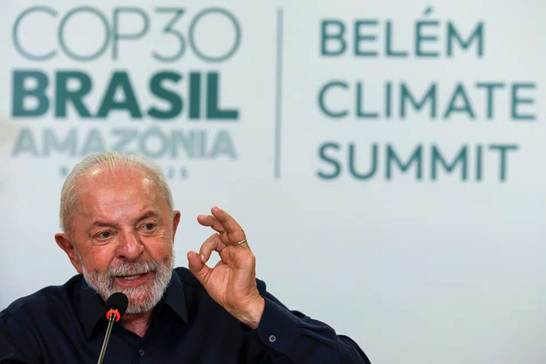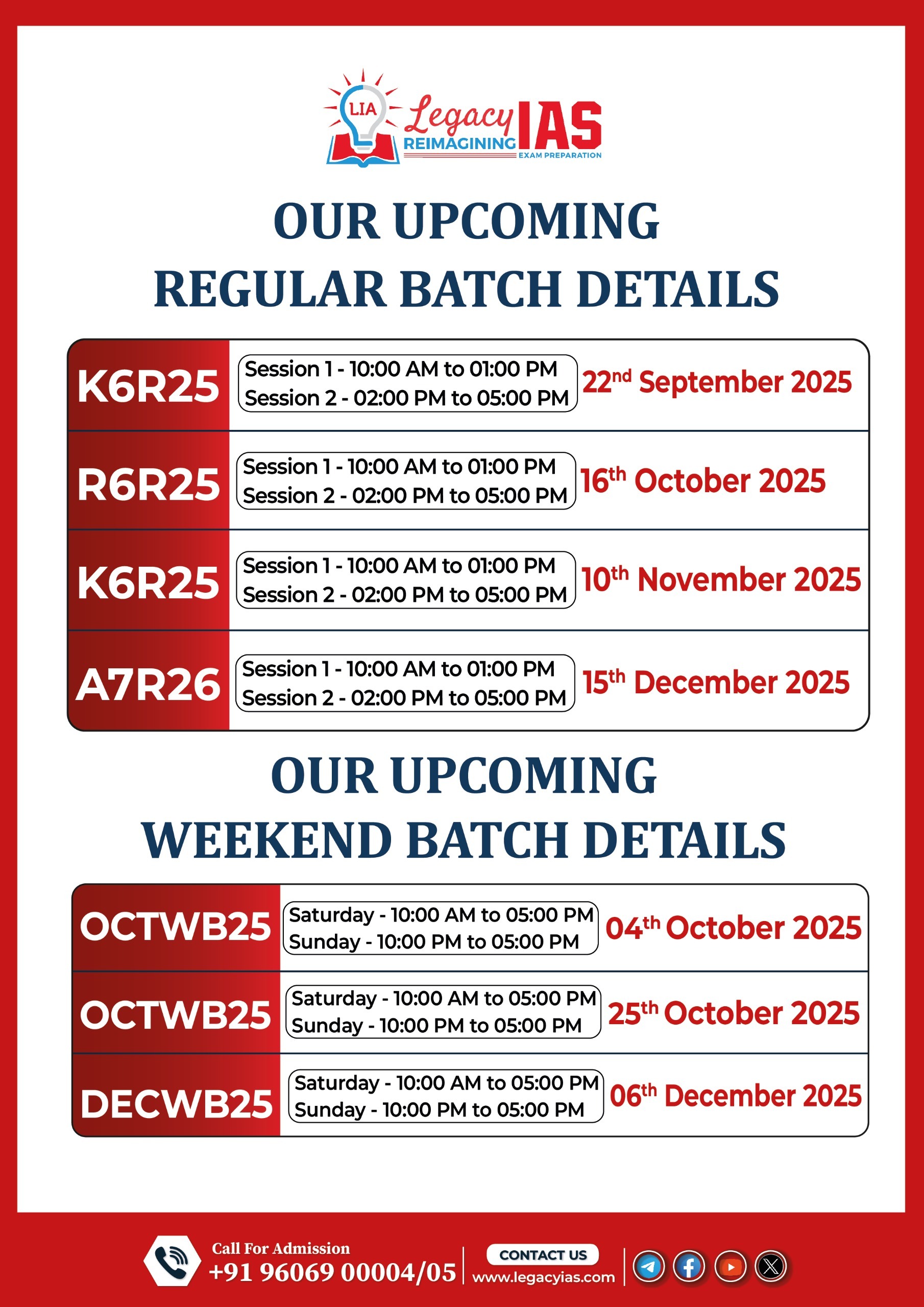Content
- Death on the Move: India’s Road Safety Crisis
- COP30 & The Belém Summit: The “COP of Truth
Death on the Move: India’s Road Safety Crisis
Why in News ?
- On November 3, 2025, a major accident near Chevella (Hyderabad) killed 19 people when a truck swerved to avoid a pothole and hit a bus on NH-163.
- The stretch lacked dividers, signages, and streetlights — reflecting India’s chronic road infrastructure and enforcement deficits.
Relevance
GS 2 (Governance):
- Administrative and institutional reforms, citizen-centric governance (RTO reforms).
GS 3 (Infrastructure & Internal Security):
- Road infrastructure, technological safety, disaster management, and resilience.
GS 4 (Ethics):
- Ethical duty of state and engineers in ensuring public safety.
Practice Question
- Despite several policy initiatives, India continues to record one of the world’s highest numbers of road fatalities. Examine the structural causes and suggest a comprehensive multi-level reform strategy.(250 Words)
The Scale of India’s Road Safety Crisis
- India tops the world in road fatalities.
- Source: MoRTH, Road Accidents in India Report 2023
- 1.68 lakh deaths in 2022 (highest ever).
- 53 road crashes and 19 deaths every hour.
- Global comparison:
- India accounts for ~11% of global road deaths, with just 1% of the world’s vehicles.
- Source: WHO Global Status Report on Road Safety 2023
- Economic cost:
- Road accidents cost India 3.14% of GDP annually (World Bank, 2020).
- Among victims, 70% are aged 18–45, the productive demographic.
Structural Causes
Infrastructure Deficits
- Poor road design and maintenance:
- 40% of accidents linked to defective road conditions (NCRB 2023).
- Absence of crash barriers, signage, lighting, and drainage systems.
- Non-adherence to Indian Roads Congress (IRC) standards:
- Many NHs/SHs lack mandated median dividers and shoulders.
- Urban-rural divide:
- 53% of road deaths occur on rural roads with inadequate visibility and enforcement.
Human Error & Licensing Failure
- Government attributes ~80% accidents to driver fault, but:
- Licensing tests focus on vehicle control, not defensive driving or risk awareness.
- No standardized training module for new drivers.
- RTO corruption and fake licences:
- SaveLIFE Foundation (2022): ~30% licences in some states issued without a test.
- World Bank (2020): 40% of Indian drivers learn driving informally.
Vehicular Safety
- Low adoption of safety technologies:
- Until 2022, airbags were optional for many vehicle models.
- Lack of collision-risk warning systems in commercial vehicles.
- Crashworthiness:
- Global NCAP scores for several Indian cars failed minimum safety benchmarks.
Enforcement Deficit
- Motor Vehicles (Amendment) Act, 2019 aimed to tighten penalties, but:
- Many States diluted or delayed implementation (e.g., Tamil Nadu, Gujarat).
- Weak enforcement of speed, helmet, seatbelt norms.
Post-Crash Care
- Golden Hour loss:
- Only 8–10% victims receive care within the critical hour.
- WHO: Delays in trauma care increase fatality risk by 30–40%.
- Regional disparity:
- States like Bihar, Jharkhand, Odisha have fatality rates 2× national average due to poor trauma infrastructure.
- Only ~600 trauma centres operational under the National Highway Accident Relief Service Scheme (NHARSS).
Dimensions of Impact
| Dimension | Impact |
| Economic | Annual loss of ₹7.5 lakh crore (MoRTH); reduces GDP growth by 1–1.5%. |
| Social | Majority of victims are low-income pedestrians, riders, and informal workers. |
| Public Health | India’s 8th leading cause of death (IHME 2022); burden on overstretched health systems. |
| Governance | Fragmented accountability between Centre, States, and local bodies. |
| Urban Planning | Poor integration of road design with pedestrian mobility and public transport. |
Government Initiatives & Reforms
Legislative
- Motor Vehicles (Amendment) Act, 2019
- ↑ Penalties for traffic violations.
- Mandatory road safety audits for NH projects.
- Provision for Good Samaritan protection.
Institutional
- National Road Safety Board (NRSB) (under MV Act 2019) – yet to be fully functional.
- National Road Safety Policy (2010) – outdated; revision pending.
Infrastructure & Technology
- Black Spot Identification Programme:
- 7,000+ accident-prone zones identified (MoRTH 2023).
- Integrated Road Accident Database (iRAD):
- Digitises crash data for targeted interventions.
- Bharatmala & PM Gati Shakti:
- Incorporating road safety audits into design stage.
- e-DAR (Detailed Accident Report) — online platform for quicker insurance and compensation.
Awareness & Capacity Building
- SaveLIFE Foundation initiatives:
- Proposal for License Seva Kendras — modelled on Passport Seva Kendras for transparent, standardised licensing.
- iSAFE Challenge by MoRTH: promoting youth engagement in safety awareness.
International Best Practices
| Country | Model | Learning for India |
| Sweden | Vision Zero (no road deaths target) | Integrate safety in design, not just enforcement. |
| Japan | Driver Re-certification every 5 years | Continuous driver education and skill audits. |
| UK | Graduated Licensing System | Stage-wise driving rights based on experience. |
| Australia | Black Spot Funding Programme | Dedicated funding for accident-prone zones. |
Way Forward: Multi-Dimensional Reform Blueprint
Policy & Institutional Reform
- Update National Road Safety Policy (2010) to align with SDG 3.6 (halve road deaths by 2030).
- Operationalise National Road Safety Board as an independent statutory body.
- Set annual state-wise targets for reduction in fatalities.
Licensing & Driver Education
- Adopt SaveLIFE Foundation’s License Seva Kendra model.
- Introduce mandatory driver education modules (simulation-based tests).
- Digitise all RTO functions to eliminate corruption.
Infrastructure Overhaul
- Ensure strict compliance with IRC standards on all NH/SH projects.
- Mandate road safety audits pre- and post-construction.
- Prioritise pedestrian and cyclist safety infrastructure (footpaths, crossings).
Vehicle & Technology Integration
- Make ADAS, collision warning, and lane departure systems mandatory in commercial vehicles.
- Incentivise scrapping of unsafe vehicles and NCAP-rated models.
Emergency & Health Systems
- Expand Golden Hour Trauma Network via PPP.
- Integrate 108 ambulance services with highway patrols.
- Strengthen AIIMS-level trauma centres across NH corridors.
COP30 & The Belém Summit: The “COP of Truth”
Why in News ?
- Belém Summit (Nov 2025) opened in the Brazilian Amazon, ahead of COP30 (to be hosted in Belém, Brazil, in 2025).
- Leaders from across the globe gathered to renew political momentum for climate justice, energy transition, and protection of tropical forests.
- Brazilian President Luiz Inácio Lula da Silva called it the “COP of Truth” — urging real action over rhetoric and proposing new global climate governance.
Relevance
GS 2 (International Relations):
- Multilateralism, international institutions, and global governance reform.
- India’s role in climate diplomacy (BASIC, G-77).
GS 3 (Environment ):
- Climate change, sustainable development, and energy transition.
- Forest conservation mechanisms and carbon finance.
GS 4 (Ethics):
- Climate ethics: Responsibility of developed nations, intergenerational justice.
Practice Question
- The Belém Summit and Brazil’s “COP of Truth” call mark a shift from climate diplomacy to climate accountability. Discuss the significance of this shift for global climate governance and the Global South.(250 Words)

The Road to COP30
| Key Milestones | Year | Significance |
| Earth Summit (Rio de Janeiro) | 1992 | Birth of UNFCCC, CBD, and UNCCD; foundation of global environmental governance. |
| Paris Agreement (COP21) | 2015 | Legally binding framework to limit global temperature rise below 2°C. |
| COP28 (Dubai) | 2023 | First Global Stocktake revealed world is off-track for 1.5°C target. |
| Belém Summit (Brazil) | 2025 | Precursor to COP30; focus on climate finance, forests, and just transition. |
Brazil’s Climate Role and the Amazon Context
- Amazon = 60% of Brazil’s territory; world’s largest rainforest, absorbing ~2 billion tonnes CO₂ annually (UNEP 2024).
- Deforestation:
- Peaked at 13,000 sq km in 2021 under Bolsonaro.
- Under Lula: ↓ 50% by 2024 (INPE data).
- Significance:
- Amazon generates 20% of world’s freshwater and regulates global carbon and rainfall cycles.
- Loss may trigger “tipping point” → irreversible savannisation (Science Advances, 2023).
The Belém Vision: Key Announcements
Tropical Forests Forever Facility (TFFF)
- New global fund model — not a donation mechanism but an investment fund.
- Reward-based approach:
- Incentivises countries for keeping forests standing.
- Attracts investors via carbon credit-based returns.
- Brazil’s initial pledge: $1 billion.
- Aims to correct “climate finance inequity” by valuing ecosystem services.
Ambitious Nationally Determined Contribution (NDC)
- Brazil: 59–67% emission reduction target by 2030 (covering all GHGs and sectors).
- Second country globally (after UAE) to submit updated NDC under the Paris framework.
- Energy transition goal:
- 88% electricity from renewables (hydro, solar, wind, biofuels).
- Green hydrogen investments: $10 bn pipeline projects (IBRD, 2024).
Declaration on Hunger, Poverty & Climate
- Links climate justice with social justice:
- 673 million hungry; 2 billion lack clean cooking fuel (FAO & IEA 2024).
- Advocates Just Transition — balancing emission cuts with livelihood protection.
Proposal for a UN Climate Change Council
- Linked to UN General Assembly, not UNSC.
- Aim: Overcome current multilateral paralysis and ensure binding accountability for climate pledges.
- Addresses global governance deficit highlighted in IPCC AR6 Synthesis Report (2023).
Underlying Issues Lula Targets
Climate Injustice
- Global North emits 10× more per capita than Global South (WRI 2024).
- Yet, 90% of climate-related deaths occur in developing countries (UNDP 2023).
- $100 billion/year finance goal (Copenhagen 2009) — still unmet.
Broken Climate Finance Architecture
- OECD 2023: Only $89.6 billion delivered in 2022; adaptation share <30%.
- Lula demands justice, not charity — fulfilling “common but differentiated responsibilities (CBDR-RC)” under UNFCCC Article 3.
Multilateral Fatigue
- Frequent pledge–delivery gap at COPs has eroded trust.
- Lula’s “COP of Truth” = call for measurable, accountable, transparent climate governance.
Brazil’s Model of Climate Leadership
| Sector | Action | Data/Outcome |
| Deforestation Control | Amazon Fund revived (with Norway & Germany support) | 50% fall in Amazon deforestation (INPE 2024). |
| Renewable Energy | 88% electricity from renewables; 47% total energy mix (IEA 2024). | Among cleanest energy systems globally. |
| Agriculture & Land Use | ABC+ Programme (Low-Carbon Agriculture) | 53 million ha under sustainable practices. |
| Urban Climate Action | Net-zero urban plan for 2035 (São Paulo) | Green hydrogen buses, electrified transit. |
Global Significance of the Belém Summit
For Climate Governance
- Potential turning point in post-Paris momentum.
- Push for binding accountability via Climate Council.
For Global South
- Strengthens South–South solidarity for climate justice and finance equity.
- Promotes a “development + decarbonisation” narrative rather than a Western mitigation-only agenda.
For Forest Economies
- TFFF could become a new financial model beyond REDD+, ensuring continuous incentives for conservation.
For COP30 (Brazil 2025)
- Sets stage for:
- Operationalising Loss & Damage Fund (COP28 outcome).
- Doubling adaptation finance and scaling forest-positive investments.
- Stocktaking of NDCs and 1.5°C progress.
Challenges & Critiques
- Financing Doubt: Unclear global buy-in for TFFF; risk of greenwashing via voluntary offsets.
- Governance Feasibility: Creating a UN Climate Council may face opposition from major powers.
- Implementation Gap: Ambitious NDCs but insufficient domestic enforcement in forest peripheries.
- Oil Transition Contradiction: Brazil still expanding offshore drilling via Petrobras.
Way Forward: Translating Belém Vision into Action
Global Level
- Operationalise Loss & Damage Fund with clear contribution metrics.
- Enforce accountability metrics for NDC delivery (through proposed UN Climate Council).
- Link SDGs–Paris–Biodiversity frameworks under a unified implementation platform.
National/Regional Level
- Integrate Just Transition Plans within NDCs.
- Scale up climate adaptation funding (currently only 20–25% of total).
- Prioritise forest-based carbon markets with strict MRV systems.
India’s Relevance
- Similar goals in LiFE Mission (Lifestyle for Environment).
- Shared advocacy with Brazil, South Africa (BASIC) for climate equity and CBDR.
- Opportunity for India–Brazil collaboration in bioenergy, green hydrogen, and South–South climate finance.



